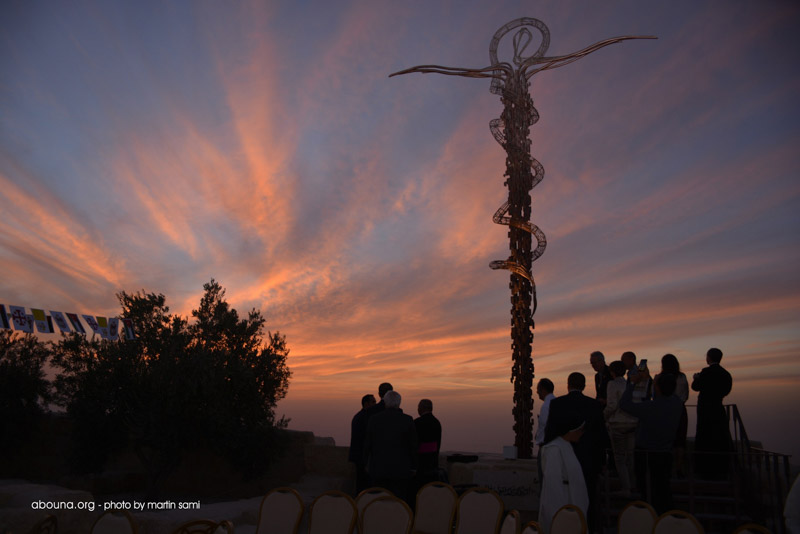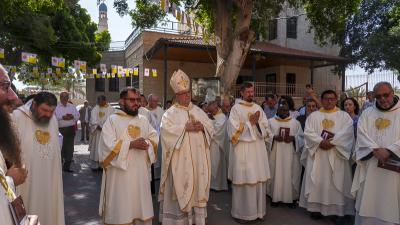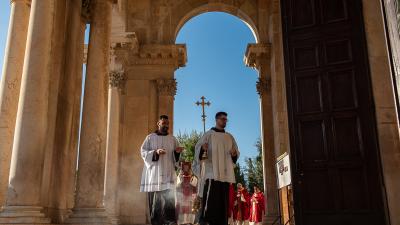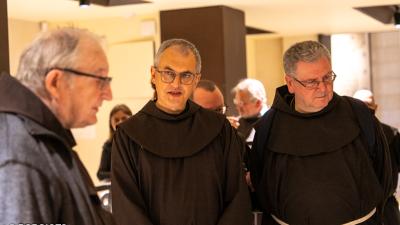
The Moses Memorial on Mount Nebo in Jordan is opening its doors to the world. On October 15 and 16, the civil and the religious opening ceremony was the official start of the life of this new Franciscan sanctuary belonging to the Custody of the Holy Land.
On May 15, Cardinal Sandri, who is the Prefect of the Congregation for Eastern Churches and Pope Francis' special envoy, together with Jordanian authorities, all made their entry onto Mount Nebo to solemn music and on a red carpet for the symbolic moment of the opening of the sanctuary's doors. Br. Rashid Mistrih first spoke through the microphone: “On the heights of Mount Nebo, the memory of Moses invites us to lift up our eyes so as to gratefully embrace not only God's marvelous works from the past, but also to look with faith and hope to the future that he has in store for us and for the whole world.” Tradition says that this is the place where Moses saw the Promised Land and where he died; it is where the story of a special man for Christianity took place. The Custody of the Holy Land is also part of that story, and it has been managing the land for decades. Specifically, it has been doing so since 1932, when, thanks to the efforts of Fr. Jerome Mihaic and the cooperation of the Emir Abdullah bin Hussein, the Franciscans bought it from members of the Wukhyan Bedouin tribe.
In his speech for the opening ceremony, the Custos of the Holy Land, Fr. Patton, thanked all of the authorities present. In the front row were dignitaries from Jordan: the governor and the mayor of Madaba and Tourism Minister Lina Annab, who represented King Abdullah II. “The reopening of this place for tours, pilgrimages and prayers is both a sign of the return to the origins of our faith, a gift for our present time, and also a promise for the future,” said Fr. Francesco Patton. After him, Mons. Sandri spoke in order to bring the message of the Holy Father Pope Francis. Mons. Sandri spoke about the importance of the Moses Memorial as a place of gathering and dialogue between the three monotheistic religions. He then addressed the Minister of Tourism from Jordan, Lina Annab, who expressed her joy in Italian: “Welcome to Jordan, your second country, the Holy Land, the land of brotherhood, peace and friendship. We are very happy to have you here.” In a relaxed and festive atmosphere, the Governor of Madaba also greeted those present, topped off with a funny joke that made the audience smile, when he accidentally put on the glasses that the minister had forgotten near the microphone.
The Custos then presented gifts to Cardinal Sandri and the Minister Lina Annab respectively: a crib and a mosque made of mother of pearl by Jerusalemite artisans. Br. Ibrahim Faltas, the former treasurer of the Custody of the Holy Land, who followed the progress of work for six years, was the last to speak and he addressed the sublimity of the location. “We come here to the top of this mountain—tourists, visitors, and pilgrims—like Moses to gaze upon the Holy Land, where the River Jordan meets the Dead Sea, upon Jericho and its oases and mountains, upon Jerusalem and its hills,” said the friar. “It allows us to anticipate a prelude of the heavenly paradise, gazing upon this earthly paradise.” In addition to the beauty described by Br Faltas, there is that of the church, which was unveiled only on October 15 for the first time, after years of anticipation.
At the end of the civil opening ceremony, after the official and symbolic opening of the doors by the Custos, the entrance to the church was opened. Inside, the splendid mosaics, dating back thousands of years, are now safely visible.
Fr. Eugenio Alliata, who has been working on the archaeological excavations since 2012, knows the history of the preservation of the mosaics well. The friar said that in the sixties the first cover was made, that was then re-arranged, and it needed to be improved over time. For this reason, before beginning the restoration work, a competition was held among world-renowned architects that rewarded the one who placed the most value in the religious aspect of the work. The progress of the work was made more challenging by the land on which the Mount Nebo sanctuary is built, because it is composed of a succession of layers of limestone and clay that render the building unstable. The problem was solved, however, by using thin poles that go down deeply and that bind to the various layers. The restoration of the church also involved the substitution of materials used in the past, with some more suitable ones, such as the titanium zinc roof. “In 2008, the work had already begun under the guidance of Fr. Piccirillo,” said Davide Bianchi, who worked with Fr. Alliata. Since 2012, archaeological investigations have focused on those points that had not been investigated previously: the nave and the presbytery. “We want the result to be good, durable and also for it to be a job that may help to train Jordanian workers and technicians, as an example of what should be done when you come across an ancient monument so that it may be preserved,” said Fr. Alliata.
On Sunday, October 16, in the newly restored church, the mass for the altar blessing took place, presided over by Cardinal Sandri and by the Custos of the Holy Land. Fr. Patton expressed joy, but also recalled the hardships: “A long series of difficulties involved the construction work, especially following the sudden death of Fr. Piccirillo, which occurred exactly eight years ago, and who we remember in a special way in this Eucharist together with Br. Mihaic.”
The Custos also hoped that, like Moses, many may experience God's grace and mercy and the promise of an eternal and blessed life. During the mass, which was filled by people from Amman, Madaba, as well as other other places, the Eucharistic altar was blessed and consecrated for the first time. In addition, a small buffet made up of sweets and Arabic coffee was served to the guests when they came out of the church. Afterwards, the evening concluded with the fourth concert of the Terra Sancta Organ Festival, with the participation of Eugenio Maria Fagiani, Tareq Al-Jundi and Nasser Salameh.
Cardinal Sandri said he was very honored to take on the role of representing Pope Francis for events in Jordan on Mount Nebo, remembering his dramatic call for a ceasefire in Syria. He also spoke about every person's search and desire for the Promised Land and that which is contrary to that search. “There are people in the world who suffer from hunger, the suppression of their dignity, because they are treated as slaves in order to be able to live: this is not the Promised Land that we expect. It would be right for these people to find a more open and generous welcome on the part of the countries that can offer one,” said the Cardinal. He also wished to make another call: “Those of us who see these difficult situations in the Middle East, have to jumpstart solidarity efforts, especially those who have the power in the world to put an end to people's suffering.”
What does visiting the Moses Memorial on Mount Nebo mean today? Commenting on the event, Fr. Patton reveals his answer: “This sanctuary takes us back to an experience that is the essence of the pilgrimage: knowing that the places we visit are not places where we stop. God wants our gaze to go beyond [those places]. So, the pilgrimage also helps us to understand that we are not called to enter the Promised Land but that we are called to enter into the promise of communion, which is our very life with God.”
Beatrice Guarrera




